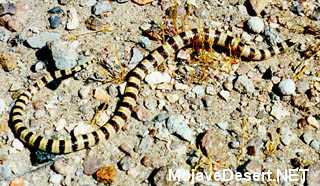Western Shovel-nosed Snake
Chionactis occipitalisFamily: Colubridae Order: Squamata Class: Reptilia
DISTRIBUTION, ABUNDANCE, AND SEASONALITY
The western shovel-nosed snake is widely distributed throughout the Mojave and Colorado
deserts below 1400 m (4700 ft). It is found most commonly in sandy barren habitats in desert
flats and washes. It can also be found in areas of scrub and less commonly in rocky areas,
slopes and canyons. It is found in greatest abundance in barren and scrub habitats with fine,
wind-blown sand about the bases of bushes and tufts of grass (Stebbins 1954).
(Habitat examples > Sand dunes,
Creosote bush scrub)
SPECIFIC HABITAT REQUIREMENTS
Feeding: This small snake eats insects and other arthropods including spiders, scorpions,
and moth larvae. In captivity, feeds on Tenebrio larvae and presumably does the same in the
wild (Stebbins 1954). Burrows or swims through sand in search of prey.
Cover: The western shovel-nosed snake burrows in fine sand. It also utilizes the burrows
of other animals. It probably requires the presence of fine sand or wind-blown sand. This
snake has also been found under surface cover objects. They are often found under bushes
or clumps of grass. Snakes often lie just under the surface of the sand where they can be
heated by the warmth of the sun without exposing themselves (Stebbins 1954).
Reproduction: Nothing is known about habitat requirements for reproduction. Eggs are
probably laid in fine sand or in burrows of other animals. The presence of fine or friable sand
is probably a requirement.
Water: Permanent water is probably never required.
Pattern: The western shovel-nosed snake prefers fine sand, but can exist in a variety of
habitats, particularly where pockets of sand are available.
SPECIES LIFE HISTORY
Activity Patterns: This snake is nocturnal. It has been observed on the surface during the
day only a few times, usually coiled under a bush. Much of its activity is probably
subterranean. It is active most of the year in the south and during the warmer months in the
north (Cowles 1941, Stebbins 1954).
Seasonal Movements/Migration: None.
Home Range: No data.
Territory: No data. Defended territories in snakes are rare but nothing is known about this
species.
Reproduction: The western shovel-nosed snake lays eggs underground. Breeds in
spring. Seven females contained an average 3.1 eggs, range 2-4 (Cowles 1941).
Niche: This snake is probably eaten by most desert predators, possibly even arthropod
predators such as large scorpions, though no reports of predation are known. Nothing is
known about parasites, diseases or competitors. This is a secretive, diminutive snake about
which very little is known.
Also See:
Joshua Tree National Park Wildlife
Mojave Shovel-nosed Snake Chionactis occipitalis occipitalis ... Brush shrouded granite boulders and cactus patches; western section (common) ...
REFERENCES
Cowles, R. B. 1941. Observations on the winter activities of desert reptiles. Ecology 22:125-140.
Stebbins, R. C. 1954. Amphibians and reptiles of western North America. McGraw-Hill, New York. 536pp.
Stebbins, R. C. 1972. California amphibians and reptiles. Univ. California Press, Berkeley. 152pp.l. Chicago Acad. Sci. 8:235-249.
Stebbins, R. C. 1954. Amphibians and reptiles of western North America. McGraw-Hill, New York. 536pp.
Woodin, W. H. 1950. Notes on Arizona species of Thamnophis. Herpetologica 6:39-40.
California Department of Fish and Game. California Interagency Wildlife Task Group.
EXTERNAL LINKS
Chionactis occipitalis annulata
Colorado Desert Shovel-nosed SnakeGenus, Chionactis, Shovel-nosed Snakes. Species, occipitalis, Western Shovel-nosed Snake. Subspecies, annulata, Colorado Desert Shovel-nosed Snake ...
Reptiles of Arizona
The Western Shovel-nosed Snake's light snout distinguishes it from the similar ... DIET: The Western Shovel-nosed Snake feeds on a variety of invertebrates ...
Western shovel-nosed snake
Arizona Flora and Fauna Image GalleryChionactis occipitalis Western shovel-nosed snake. Maricopa Co.- Sun Valley Parkway 20 May 2005. Copyright © 2004 Photo by Ryan Sawby.
The Tucson Herpetological Society
Western Shovel-nosed Snake (Chionactis occipitalis) ... Tucson Shovel-nosed Snake Chionactis occipitalis klauberi. photo by Erik F. Enderson ...
Tucson Shovel-nosed Snake
The Tucson shovel-nosed snake is a subspecies of the western shovel-nosed ... Other subspecies of western shovel-nosed snakes can be found from southwest ...
Organ Pipe Shovel-nosed Snake
The ground surface may be rocky or sandy, but is generally coarser and more irregular than that occupied by the Western Shovel-nosed Snake (C. occipitalis). ...
Reptiles of Arizona
The Sonoran Shovel-nosed Snake's light snout distinguishes it from the similar looking Sonoran Coralsnake which has a black snout. The similar Western ...
 Western Shovel-nosed snake
Western Shovel-nosed snakePhoto courtesy of National Nuclear Security Administration / Nevada Site Office